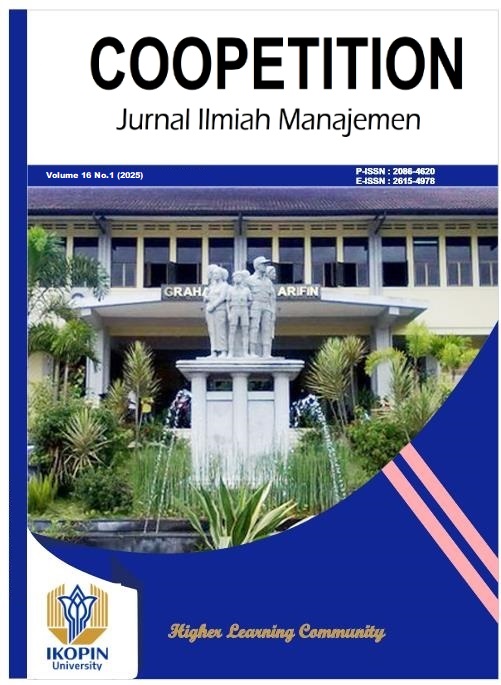Pengaruh Overconfidence Bias terhadap Pengambilan Keputusan Investasi di Pasar Saham Selama Perang Rusia-Ukraina
DOI:
https://doi.org/10.32670/coopetition.v16i1.5011Keywords:
Kata Kunci: Overconfidence bias, Keputusan investasi, volatilitas pasar, sentiment pasar, pasar saham Indonesia, aktivitas investor.Abstract
This study examines the impact of overconfidence bias on investment decision-making during the Rusia-Ikraine war in the Indonesian energy stock market. Overconfidence bias is a cognitive bias where investors overestimate their ability to predict market movements, often leading to an increase in transaction frequency and the taking of irrational risks. Using stock return data from the companies INCO, ADRO, ITMG, and the JKSE during the 2022-2024 activity lever segregation methods to explore this phenomenon. The results indicate that high market volatility exerbates overconfidence bias, particulary among investors with high activity levels leading to more frequent transactions and suboptimal investment decisions. In contrast, investors with lower activity levels tend to exhibit more rational behavior, maintaining better portolio stability during extreme market conditions promote more rational decision-making. These findings contribute sifnificantly to the understanding of investor psychology the importance of strategies to mitigate cognitive biases, especially during periods of high market volatility.
Downloads
References
Baker, M., & Wurgler, J. (2007). Investor sentiment in the stock market. Journal of Economic Perspectives, 21(2), 129–151. https://doi.org/10.1257/jep.21.2.129
Barber, B. M., & Odean, T. (2001). Boys will be boys: Gender, overconfidence, and common stock investment. Quarterly Journal of Economics, 116(1), 261–292. https://doi.org/10.1162/003355301556400
Barber, B. M., Odean, T., & Zhu, N. (2009). Do retail trades move markets? Review of Financial Studies, 22(1), 151–186. https://doi.org/10.1093/rfs/hhn035
Chan, W. C. (2003). Stock price reaction to news and no-news: Drift and reversal after headlines. Journal of Financial Economics, 70(2), 223–260. https://doi.org/10.1016/S0304-405X(03)00146-6
Chen, H., De, P., Hu, Y., & Hwang, B. H. (2014). Wisdom of crowds: The value of stock opinions transmitted through social media. Review of Financial Studies, 27(5), 1367–1403. https://doi.org/10.1093/rfs/hhu001
Chen, T. Y., Huang, G. Y., & Wu, Z. X. (2022). Overreaction-based momentum in the real estate investment trust market. International Review of Finance, 22(3), 453–471. https://doi.org/10.1111/irfi.12358
Fisher, K. L., & Statman, M. (2000). Investor Sentiment and Stock Returns. Financial Analysts Journal, 56(2), 16–23. https://doi.org/10.2469/faj.v56.n2.2340
Glaser, M., & Weber, M. (2009). Which past returns affect trading volume? Journal of Financial Markets, 12(1), 1–31. https://doi.org/10.1016/j.finmar.2008.03.001
Hirshleifer, D. (2001). Investor Psychology and Asset Pricing Hirshleifer 2001.pdf. The Journal of Finance, LVI(4), 493–494. https://www.bus.umich.edu/pdf/mitsui/nttdocs/hirshleifer-Investor_Psychology.pdf
Kahneman, D., & Tversky, A. (1979). Prospect Theory: An Analysis of Decision under risk. The Economy Society, 47(2), 263–292.
Odean, T. (1998). Volume, volatility, price, and profit when all traders are above average. Journal of Finance, 53(6), 1887–1934. https://doi.org/10.1111/0022-1082.00078
Odean, T. (2011). Do investors trade too much? Advances in Behavioral Economics, 606–632. https://doi.org/10.2307/j.ctvcm4j8j.28
Pompian.M.Michael. (n.d.). Behavioral Finance and Investor Types. file:///C:/Users/LENOVO/Downloads/Behavioral Finance and Investor Types Managing Behavior to Make Better Investment Decisions ( PDFDrive ).pdf
Shiller, R. J. (2014). Behavioral finance. Megatrend Revija, 11(2), 73–94. https://doi.org/10.5937/megrev1402073k
Statman, M., Thorley, S., & Vorkink, K. (2006). Investor overconfidence and trading volume. Review of Financial Studies, 19(4), 1531–1565. https://doi.org/10.1093/rfs/hhj032
Thaler, R. H. (2005). Advances in behavioral finance. Advances in Behavioral Finance, 2, 1–694. https://doi.org/10.2307/2329257
Wang, W., Su, C., & Duxbury, D. (2021). Investor sentiment and stock returns: Global evidence. Journal of Empirical Finance, 63(June 2019), 365–391. https://doi.org/10.1016/j.jempfin.2021.07.010
Downloads
Published
How to Cite
Issue
Section
License
Copyright (c) 2025 Coopetition : Jurnal Ilmiah Manajemen

This work is licensed under a Creative Commons Attribution 4.0 International License.


















